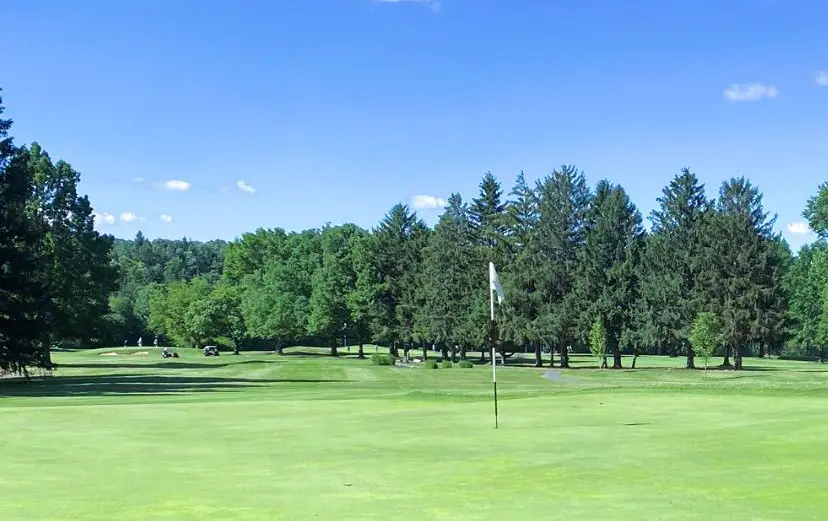Keeping a golf course in perfect shape takes a lot of work. Luckily, course superintendents have a lot of tools at their disposal to keep the course looking its best. One of the most important tools they have in their arsenal is fertilizer.
Golf course groundskeepers use fertilization to promote and maintain healthy turf. However, optimizing a fertilizer schedule can be a difficult task as each course has its own unique needs.
Factors such as climate, grass type, turf age and condition, and foot traffic all play a role in determining how often a course needs to be fertilized.
In the article below, we are going to cover all you need to know about how often golf courses fertilize the course and what factors impact the frequency. We have a lot to cover so let’s get started!

How Often Do Golf Courses Fertilize?
Golf courses may use a variety of fertilizers to address specific nutrient deficiencies in the soil. A regular fertilization routine helps to ensure that the turf receives all the necessary nutrients it needs to thrive.
Soil testing and industry standards can be used to determine the right type and amount of fertilizer. Irrigation and other techniques can help to maximize the effectiveness of fertilization efforts.
4 Factors That Can Affect Fertilization Frequency
1) Climate And Weather Patterns
Climate and weather patterns can have a considerable impact on a golf course’s fertilizer requirements. In hot and dry conditions, for example, the turf may require more frequent fertilization to compensate for increased water demand.
Cool and damp weather, on the other hand, may allow for less frequent fertilization. To ensure that the turf receives the nutrients it requires to grow, golf course management should monitor weather patterns and alter fertilization programs accordingly.
It is also important to evaluate the normal meteorological conditions for the region in which the course is located, as this can serve to inform the formulation of a long-term fertilization plan.
2) Type Of Grass On The Course
The type of grass on a golf course can also influence fertilization requirements. Different species of grass have different nutritional requirements and weather tolerances, which might impact the frequency and type of fertilization required.
Some grasses may be more drought-tolerant and require less frequent fertilization, while others may be more susceptible to high temperature changes and require more regular fertilization.
Golf course managers must be conversant with the individual needs of the grasses on their course and adapt fertilization programs accordingly. Furthermore, utilizing the proper fertilizer for the specific grass variety might help to guarantee that the turf receives the nutrients it requires to thrive.

3) Age And Condition Of The Turf
The age and quality of a golf course’s turf can have an impact on fertilization requirements. To preserve its health and resilience, older turf may require more frequent fertilization, whereas younger turf may require less frequent fertilization.
The turf’s condition is also crucial, as good turf absorbs nutrients better and may require less fertilizing. Turf that is stressed or damaged, on the other hand, may require more frequent fertilization to recover. Golf course management should check the age and condition of their course’s grass on a regular basis and change fertilization regimens accordingly.
Other appropriate lawn management methods, such as correct mowing and watering, can also help to preserve the turf’s general health and condition.
4) Level Of Play And Foot Traffic On The Course
The level of play and foot traffic on a golf course can impact the fertilization needs of the turf. Higher levels of play and foot traffic can place increased stress on the turf, which may require more frequent fertilization to maintain its health and resilience.
On the other hand, courses with lower levels of play and foot traffic may require less frequent fertilization. Golf course managers should consider the level of play and foot traffic on their course when determining fertilization needs and schedules.
Additionally, implementing other good turf management practices, such as proper mowing and watering, can help to reduce the impact of foot traffic and maintain the overall health of the turf.
Best Practices For Fertilization In Golf Course Management
The best fertilization practices for golf course management involve using soil tests to precisely identify nutrient deficiencies and putting in place a regular fertilization schedule to make sure that the turf receives the nutrients it requires to thrive.
To maximize the efficiency of fertilization efforts, the right type and quantity of fertilizer should be chosen based on the findings of soil tests and industry standards.
To assist the turf in absorbing nutrients and preserving a strong root system, irrigation as well as other methods, including topdressing and aeration, can be used.
Final Thoughts
For golf courses to remain healthy and well-maintained, proper fertilization is essential. When deciding on fertilization frequency and best practices, golf course managers must consider several variables, such as climate and weather patterns, grass type, turf age and condition, level of play, and foot traffic.
Golf course managers can make sure that their courses are well-nourished and in excellent condition by using soil tests, implementing a regular fertilization schedule, and choosing the right type and amount of fertilizer.
Hopefully, you liked this article and found it informative. Check out our other blog posts if you liked this one!


